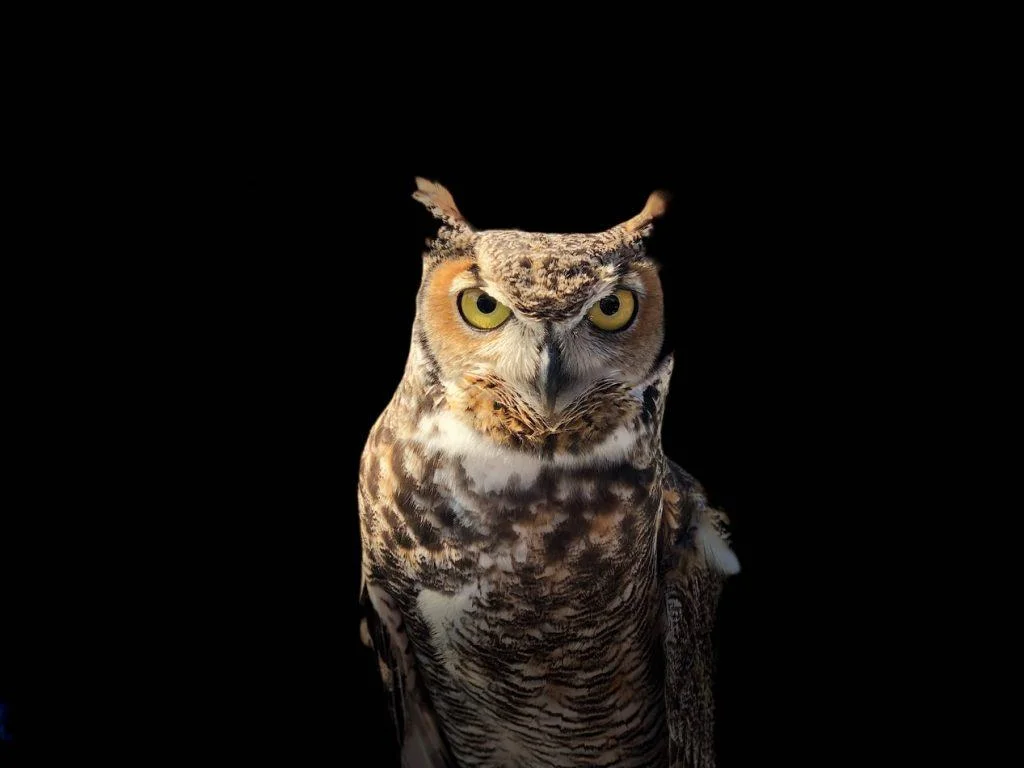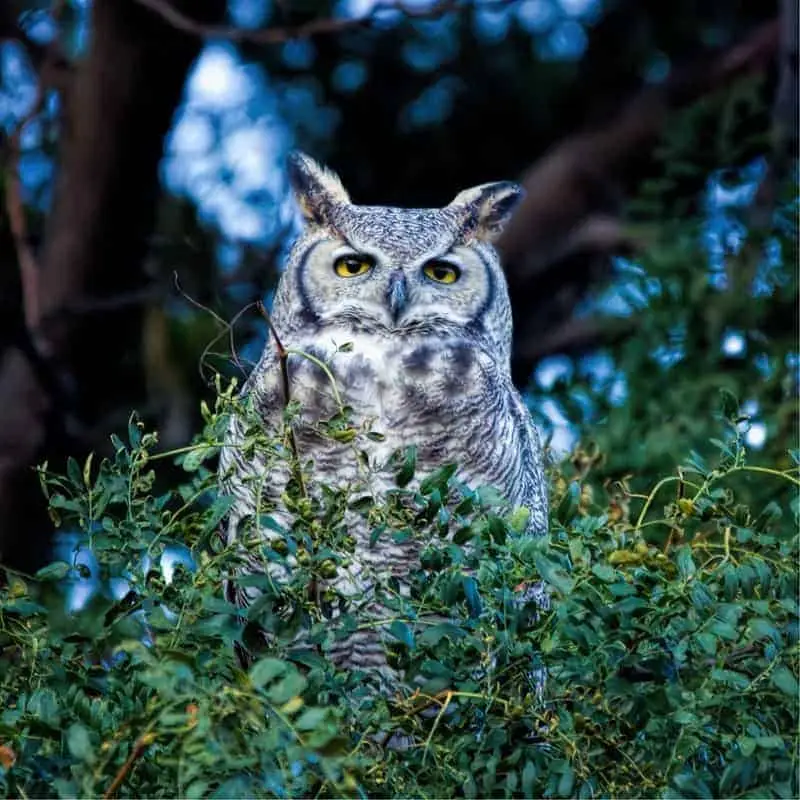
Want to learn more? This National Geographic Book on Owls is a great read!
The Short-Eared Owl is the least common of these species to be found in the state whilst the Great Horned Owl is the most commonly found owl in Alabama.
Alabama is a south eastern state with a temperate climate. This means that the winters are mild and due to Alabama’s position, it can also be affected by winds from the coast of Mexico.
There are 21 different state parks throughout Alabama and there are 9 different national parks. These parks are well known for not only preserving nature but for telling stories of human history in historic sites.
Now that we’ve looked at the state of Alabama, let’s have a look at the individual owl species that can be found there. We’ll also have a look at when and where in the state you can see these different owls.
Want to attract Owls to your yard? Take a look at our article!
What Owls can be seen in Alabama?
Table of Contents
1. Barn Owl

Wingspan
107 to 110 cm
Weight
430 – 620 g
Life Expectancy
Up to 4 years
Diet
Voles, Shrews & Mice
Barn Owls are covered in pale feathers. These feathers are a mix of buff and grey on both the head and their wings.
During the daytime these colours are more noticeable whilst at night they can appear completely white. These medium sized owls can be found across 48 states in America and will occasionally stray into southern Canada.
They make their nests and territories in open country areas such as grasslands. Whilst there have been reports of barn owls mating with several females, most of them remain monogamous and form long-lasting breeding pairs.
Males will bring food to the females as she gets the nest ready for incubation. These birds are protective of their nests, but they happily share hunting grounds with others of their species.
With a range of 48 states, it is not surprising that Barn Owls can be seen throughout all regions of Alabama.
As well as this, they are permanent residents so can be seen in the state throughout the whole year. The highest recorded number of sightings has been in the eastern half of the state.
2. Eastern Screech Owl

Wingspan
46 to 61 cm
Weight
160 g
Life Expectancy
14 years
Diet
Rats, Squirrels, Rabbits & Skunks
These birds have small and stocky bodies and are covered in grey feathers, as the name suggests they are found through the eastern states whilst the Western Screech Owl is seen to the west of the United States.
Eastern Screech-Owls will form breeding pairs and will help raise young together, however these pairs are not long term. Sometimes males will mate with two females, but most stay monogamous.
Males do most of the work when defending their small territories and will also feed females and their young when they first hatch.
These owls make their habitats in dense forests and utilise any man-made bird boxes that have been added to their territory. They have also been known to nest and breed successfully in city parks and farmlands.
The Eastern-Screech owl is a year-round resident in the state of Alabama so it can be seen both during and outside of its breeding season.
Its range encompasses all the regions of the state but the most commonly recorded sightings have been to the north west of the state whilst the lowest recordings have been to the south of Alabama.
3. Great Horned Owl

Wingspan
~140cm
Weight
1.4 kg
Life Expectancy
28 years old
Diet
Squirrels, Rabbits & Skunks
This owl’s most identifiable feature is its pointed ear tufts that look like horns on top of their heads, which is also where they get their name.
Their feathers are greyish brown shades and they are thick to cover its stocky body.
These birds form long term breeding pairs, the breeding pairs have been known to stay with each other outside of the breeding season.
They also remain monogamous to their partner and are territorial birds. These owls have a series of hoots that they will use to defend their territory and both members of the breeding pair will help defend their nests.
In fact, these birds are so territorial that they have at times been known to kill other individuals of their own species as well as different bird species.
They are often harassed by other species of birds such as crows which will call and peck at them to try and get them to abandon the area and their eggs.
With the widest range of all of the mentioned owls, it is to be expected that these birds have a range which includes all the regions in Alabama. Thankfully, it does, and they can be seen throughout the whole year in the state of Alabama.
Most of the sightings of this owl have been recorded in the south western areas of the state.
4. Short-Eared Owl

Wingspan
85 to 110 cm
Weight
206–475 g
Life Expectancy
4-12 years
Diet
Voles, Mice, Squirrels
Short-eared owls are a medium sized species of owl that are covered in brown and white spotted feathers.
Their name comes from the fact that they have outwards ear-tufts that are so small that they are barely visible. These owls will hunt during both the day and the night and you are most likely to see one in areas of low vegetation.
Short-eared owls form loose colonies and are monogamous maters during the breeding season, but it is unknown as to whether they stay together for multiple seasons.
Breeding pairs will make their roosts on the ground in areas of tall grass, they only tend to roost in trees during the winter months especially when it is snowy.
Males will feed the females whilst they are incubating the eggs and will also help defend their territory with a series of harsh calls.
These owls have a wide range across the United states and can be seen in all regions of Alabama.
However, they cannot be seen throughout the year and are only seen in the during outside of their breeding seasons.
The most common area of sightings is in the south east region of the state whilst they have least commonly seen in the central regions of Alabama.
5. Barred Owl

Wingspan
96-125 cm
Weight
468-1,150 g
Life Expectancy
10-23 years
Diet
Small mammals
Barred Owls are a large and stocky species of owl and they are covered with brown and white barred feathers.
These owls habituate close to bodies of water and make their habitats in areas of dense and mature forests, where they are able.
Barred Owls are very territorial, and females are the more aggressive ones, however this is only during the breeding season, but they will remain defensive throughout the rest of the year.
To defend their territory, they have been observed using a kind of flight attack where they will collide into other birds, talons first.
These birds are monogamous and are believed to mate for life.
They will raise a single brood of eggs together and if there is a predator, one parent will leave the nest to cause a noisy distraction and prevent the young from being attacked.
The Barred Owl has possibly the smallest range of all of the owls mentioned. That being said, they can still be seen in all regions of Alabama and are permanent residents. This means they can be seen in the state both during and outside of their breeding seasons.
The most common area for sightings is the south west of the state whilst the lowest number of recorded sightings are in the north east of the state.

More Articles.

What Birds of Prey can be seen in France? (10 Species with Pictures and Sounds)
France is filled with numerous birds of prey. Its variable habitat from the mountains of

What does seeing a Crow Symbolize?
Seeing a Crow can mean many things, it could mean that you retrieve insight and

What Hawks can you see in Germany? (3 Species with Pictures & Sounds)
What Hawks can you see in Germany? There are 3 different species of Hawks that

About Us
We are avid bird-watchers who recently retired, allowing us more time to travel the world. Fortunately, we have managed to visit numerous countries around Europe, Asia, and America. Watching and photographing birds has been a passion for many years and we are making the most of the extra time on our hands!
